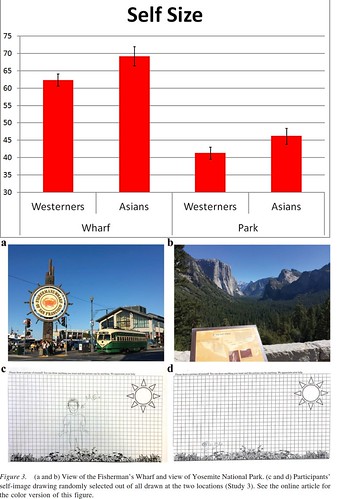Sunday, September 17, 2017
Hidden by Awe: Asian Positivity almost out of the Closet

In recent research (Takemoto, 2017 in Japanese) I have argued that the size and positivity of self-drawings are a better measure of Japanese positive self regard that self-esteem scale scores and found that self-drawing size correlates with perceived social support in Japanese males, and that positivity of self drawing (as measure by independent evaluators) correlates with perceived social support in both Japanese male and female students, whereas self-esteem is not predictive of social support at all. In the vernacular, Japanese people who 'stand tall' with good comportment and positive, large body image are popular, but people with 'big mouths' and high self-esteem are not especially popular at all.
In a recent esteemed study (Bai et al., 2017), in the most impactful social psychological journal, a similar result was hidden in a paper on "awe". First of it reported that in an initial 7 item scale selection of self-size, where participants were asked to circle a self-drawing that was appropriate in size to themselves from large (like the above bottom left) or small (like bottom right) was found to correlate strongly with linguistic measures of, above all self-esteem (r=.64**), perceived power (r=.61), general self-efficacy (r=.5**), sociometric-status (r=.47**) and self-entitlement (r=.2**) but not with height nor weight.
The fact, however, that Asian perceived self-sizes, when measured with a self-drawing at least, were larger than those of Westerners hardly receives attention at all, hidden as it was in considerations of "awe," which Westerners are more sensitive to, in Yosemite Park for instance. May the Gods of social psychology forbid that Asians are ever found to be more positive than Westerners! The above graph shows the average number of squares covered by self drawings adapted from Table 2 (Bai, et al., 2017 p.6) where Westerners are the average of North American and European respondents.
The same pattern was found for the size of "signature" (me, 我, 私)but since this will depend upon the script only in-country correlations would be meaningful, and provides an interesting connection between Asian self-esteem and calligraphy.
For how much longer will Asian visual positivity remain hidden? It will not be long now. The problem then arises, if the self is both linguistically and visually represented, who is it represented to?
The bottom half of the above image is reproduced without permission from Bai et al., 2007, figure 3, page 10. Should you wish for me to cease and desist please leave a comment or drop me an email to the email link at nihonbunka.com
Bai, Y., Maruskin, L. A., Chen, S., Gordon, A. M., Stellar, J. E., McNeil, G. D., … Keltner, D. (2017). Awe, the Diminished Self, and Collective Engagement: Universals and Cultural Variations in the Small Self. Retrieved from psycnet.apa.org/psycinfo/2017-20208-001/
Takemoto, T. 武本, Timothy. (2017). ジマンガ:日本人の心像的自尊心を測る試み(Auto-Manga as Prideful-Pictures: An Attempt to Measure Japanese Mental Image Self-Esteem). 山口経済学雑誌= Yamaguchi Journal of Economics, Business Administrations & Laws, 65(6), 107–138. Retrieved from nihonbunka.com/docs/Jimanga.pdf
Labels: cultural psychology, culture, mirror, Nacalian, nihonbunka, 日本文化
This blog represents the opinions of the author, Timothy Takemoto, and not the opinions of his employer.
